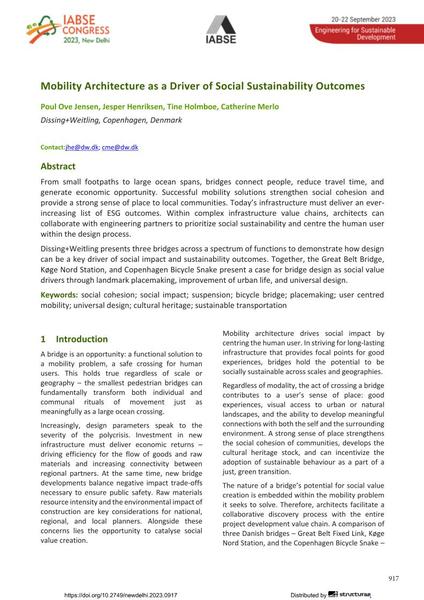Mobility Architecture as a Driver of Social Sustainability Outcomes

|
|
|||||||||||
Bibliografische Angaben
| Autor(en): |
Poul Ove Jensen
(Dissing+Weitling, Copenhagen, Denmark)
Jesper Henriksen (Dissing+Weitling, Copenhagen, Denmark) Tine Holmboe (Dissing+Weitling, Copenhagen, Denmark) Catherine Merlo (Dissing+Weitling, Copenhagen, Denmark) |
||||
|---|---|---|---|---|---|
| Medium: | Tagungsbeitrag | ||||
| Sprache(n): | Englisch | ||||
| Tagung: | IABSE Congress: Engineering for Sustainable Development, New Delhi, India, 20-22 September 2023 | ||||
| Veröffentlicht in: | IABSE Congress New Delhi 2023 | ||||
|
|||||
| Seite(n): | 917-925 | ||||
| Anzahl der Seiten (im PDF): | 9 | ||||
| DOI: | 10.2749/newdelhi.2023.0917 | ||||
| Abstrakt: |
From small footpaths to large ocean spans, bridges connect people, reduce travel time, and generate economic opportunity. Successful mobility solutions strengthen social cohesion and provide a strong sense of place to local communities. Today’s infrastructure must deliver an ever- increasing list of ESG outcomes. Within complex infrastructure value chains, architects can collaborate with engineering partners to prioritize social sustainability and centre the human user within the design process. Dissing+Weitling presents three bridges across a spectrum of functions to demonstrate how design can be a key driver of social impact and sustainability outcomes. Together, the Great Belt Bridge, Køge Nord Station, and Copenhagen Bicycle Snake present a case for bridge design as social value drivers through landmark placemaking, improvement of urban life, and universal design. |
||||
| Stichwörter: |
Suspension Kulturerbe
|
||||
